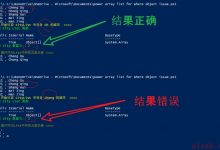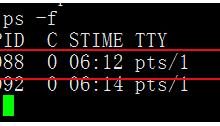大数据程序员为什么要学习Shell呢?(脚本开发)
1)需要看懂运维人员编写的Shell程序。
2)偶尔会编写一些简单Shell程序来管理集群、提高开发效率。
第2章 Shell解析器
(1)Linux提供的Shell解析器有:
[shell@hadoop101 ~]$ cat /etc/shells
/bin/sh
/bin/bash(常用解析器)
/sbin/nologin
/bin/dash
/bin/tcsh
/bin/csh
(2)bash和sh的关系
[shell@hadoop101 bin]$ ll | grep bash
-rwxr-xr-x. 1 root root 941880 5月 11 2016 bash
lrwxrwxrwx. 1 root root 4 5月 27 2017 sh -> bash
(3)Centos默认的解析器是bash
[shell@hadoop102 bin]$ echo KaTeX parse error: Expected \’EOF\’, got \’#\’ at position 58: …码里面)1.脚本格式脚本以#̲!/bin/bash开头(指定… touch helloworld.sh
[shell@hadoop101 datas]$ vi helloworld.sh
在helloworld.sh中输入如下内容
#!/bin/bash
echo “helloworld”
(3)脚本的常用执行方式
第一种:采用bash或sh+脚本的相对路径或绝对路径(不用赋予脚本+x权限)
sh+脚本的相对路径
[shell@hadoop101 datas]$ sh helloworld.sh
Helloworld
sh+脚本的绝对路径
[shell@hadoop101 datas]$ sh /home/shell/datas/helloworld.sh
helloworld
bash+脚本的相对路径
[shell@hadoop101 datas]$ bash helloworld.sh
Helloworld
bash+脚本的绝对路径
[shell@hadoop101 datas]$ bash /home/shell/datas/helloworld.sh
Helloworld
第二种:采用输入脚本的绝对路径或相对路径执行脚本(必须具有可执行权限+x)
(a)首先要赋予helloworld.sh 脚本的+x权限
[shell@hadoop101 datas]$ chmod 777 helloworld.sh
(b)执行脚本
相对路径
[shell@hadoop101 datas]$ ./helloworld.sh
Helloworld
绝对路径
[shell@hadoop101 datas]$ /home/shell/datas/helloworld.sh
Helloworld
注意:第一种执行方法,本质是bash解析器帮你执行脚本,所以脚本本身不需要执行权限。第二种执行方法,本质是脚本需要自己执行,所以需要执行权限。
第三种:在脚本的路径前加上“.”
(a)有以下脚本
[root@0725pc shells]# cat test1.sh
#! /bin/bash
A=“hello”
(b) 分别使用sh,bash,./ 和 . 的方式来执行,结果如下:
[root@0725pc shells]# bash test1.sh
[root@0725pc shells]# echo $A
[root@0725pc shells]# sh test1.sh
[root@0725pc shells]# echo $A
[root@0725pc shells]# ./test1.sh
[root@0725pc shells]# echo $A
[root@0725pc shells]# . test1.sh
[root@0725pc shells]# echo $A
hello (只在这里得到了显示)
原因:
前三种方式都是在当前shell中打开一个子shell来执行脚本内容,当脚本内容结束,则子shell关闭,回到父shell中。
第四种,也就是使用在脚本路径前加.的方式,可以使脚本内容在当前shell里执行,而无需打开子shell!
开子shell与不开子shell的区别就在于,环境变量的继承关系,如在子shell中设置的当前变量,父shell是不可见的。
3.第二个Shell脚本:多命令处理
(1)需求:
在/home/shell/目录下创建一个banzhang.txt,在banzhang.txt文件中增加“I love cls”。
(2)案例实操:(输出的结果是什么)
[shell@hadoop101 datas]$ touch batch.sh
[shell@hadoop101 datas]$ vi batch.sh
在batch.sh中输入如下内容
#!/bin/bash
cd /home/shell
touch cls.txt
echo “I love cls” >>cls.txt (输出)
第4章 Shell中的变量
4.1 系统变量
- 常用系统变量
HOME、HOME、HOME、PWD、SHELL等2.案例实操(1)查看系统变量的值[shell@hadoop101datas]SHELL等2.案例实操(1)查看系统变量的值[shell@hadoop101 datas]SHELL等2.案例实操(1)查看系统变量的值[shell@hadoop101datas] echo HOME/home/shell(2)显示当前Shell中所有变量:set[shell@hadoop101datas]HOME/home/shell(2)显示当前Shell中所有变量:set[shell@hadoop101 datas]HOME/home/shell(2)显示当前Shell中所有变量:set[shell@hadoop101datas] set
BASH=/bin/bash
BASH_ALIASES=()
BASH_ARGC=()
BASH_ARGV=()
4.2 自定义变量
1.基本语法(区分大小写)
(1)定义变量:变量=值
(2)撤销变量:unset 变量
(3)声明静态变量:readonly变量,注意:不能unset
2.变量定义规则
(1)变量名称可以由字母、数字和下划线组成,但是不能以数字开头,环境变量名建议大写。
(2)等号两侧不能有空格
(3)在bash中,变量默认类型都是字符串类型,无法直接进行数值运算。
(4)变量的值如果有空格,需要使用双引号或单引号括起来。
3.案例实操
(1)定义变量A
[shell@hadoop101 datas]$ A=5
[shell@hadoop101 datas]$ echo A5(2)给变量A重新赋值[shell@hadoop101datas]A5(2)给变量A重新赋值[shell@hadoop101 datas]A5(2)给变量A重新赋值[shell@hadoop101datas] A=8
[shell@hadoop101 datas]$ echo A8(3)撤销变量A[shell@hadoop101datas]A8(3)撤销变量A[shell@hadoop101 datas]A8(3)撤销变量A[shell@hadoop101datas] unset A
[shell@hadoop101 datas]$ echo A(再输出不会显示)(4)声明静态的变量B=2,不能unset[shell@hadoop101datas]A(再输出不会显示)(4)声明静态的变量B=2,不能unset[shell@hadoop101 datas]A(再输出不会显示)(4)声明静态的变量B=2,不能unset[shell@hadoop101datas] readonly B=2
[shell@hadoop101 datas]$ echo B2[shell@hadoop101datas]B2[shell@hadoop101 datas]B2[shell@hadoop101datas] B=9
-bash: B: readonly variable
(5)在bash中,变量默认类型都是字符串类型,无法直接进行数值运算
[shell@hadoop102 ~]$ C=1+2
[shell@hadoop102 ~]$ echo C1+2(6)变量的值如果有空格,需要使用双引号或单引号括起来[shell@hadoop102]C1+2(6)变量的值如果有空格,需要使用双引号或单引号括起来[shell@hadoop102 ~]C1+2(6)变量的值如果有空格,需要使用双引号或单引号括起来[shell@hadoop102] D=I love banzhang
-bash: world: command not found
[shell@hadoop102 ~]$ D=“I love banzhang”
[shell@hadoop102 ~]$ echo AIlovebanzhang(7)可把变量提升为全局环境变量,可供其他Shell程序使用export变量名[shell@hadoop101datas]AI love banzhang(7)可把变量提升为全局环境变量,可供其他Shell程序使用export 变量名[shell@hadoop101 datas]AIlovebanzhang(7)可把变量提升为全局环境变量,可供其他Shell程序使用export变量名[shell@hadoop101datas] vim helloworld.sh
在helloworld.sh文件中增加echo $B
#!/bin/bash
echo “helloworld”
echo $B
[shell@hadoop101 datas]$ ./helloworld.sh
Helloworld
发现并没有打印输出变量B的值。
[shell@hadoop101 datas]$ export B(设置为全局变量)
[shell@hadoop101 datas]$ ./helloworld.sh
helloworld
2
4.3 特殊变量:$n
1.基本语法
$n (功能描述:n为数字,$0代表该脚本名称,$1-9代表第一到第九个参数,十以上的参数,十以上的参数需要用大括号包含,如9代表第一到第九个参数,十以上的参数,十以上的参数需要用大括号包含,如9代表第一到第九个参数,十以上的参数,十以上的参数需要用大括号包含,如{10})
2.案例实操
(1)输出该脚本文件名称、输入参数1和输入参数2 的值
[shell@hadoop101 datas]$ touch parameter.sh
[shell@hadoop101 datas]$ vim parameter.sh
#!/bin/bash
echo “$0 $1 $2”(不加引号也可以)
[shell@hadoop101 datas]$ chmod 777 parameter.sh
[shell@hadoop101 datas]$ ./parameter.sh cls xz
./parameter.sh cls xz
4.4 特殊变量:$#
1.基本语法
KaTeX parse error: Expected \’EOF\’, got \’#\’ at position 1: #̲ (功能描述:获取所有输入参数… vim parameter.sh
#!/bin/bash
echo “$0 $1 $2”
echo $#
[shell@hadoop101 datas]$ chmod 777 parameter.sh
[shell@hadoop101 datas]$ ./parameter.sh cls xz
parameter.sh cls xz
2
4.5 特殊变量:∗、*、∗、@
1.基本语法
∗(功能描述:这个变量代表命令行中所有的参数,* (功能描述:这个变量代表命令行中所有的参数,∗(功能描述:这个变量代表命令行中所有的参数,*把所有的参数看成一个整体,各参)
@(功能描述:这个变量也代表命令行中所有的参数,不过@ (功能描述:这个变量也代表命令行中所有的参数,不过@(功能描述:这个变量也代表命令行中所有的参数,不过@把每个参数区分对待)
2.案例实操
(1)打印输入的所有参数
[shell@hadoop101 datas]$ vim parameter.sh
#!/bin/bash
echo “$0 $1 $2”
echo $#
echo $*
echo $@
[shell@hadoop101 datas]$ bash parameter.sh 1 2 3
parameter.sh 1 2
3
1 2 3
1 2 3
4.6 特殊变量:$?
1.基本语法
?(功能描述:最后一次执行的命令的返回状态。如果这个变量的值为0,证明上一个命令正确执行;如果这个变量的值为非0(具体是哪个数,由命令自己来决定),则证明上一个命令执行不正确了。)2.案例实操(1)判断helloworld.sh脚本是否正确执行[shell@hadoop101datas]? (功能描述:最后一次执行的命令的返回状态。如果这个变量的值为0,证明上一个命令正确执行;如果这个变量的值为非0(具体是哪个数,由命令自己来决定),则证明上一个命令执行不正确了。)2.案例实操(1)判断helloworld.sh脚本是否正确执行[shell@hadoop101 datas]?(功能描述:最后一次执行的命令的返回状态。如果这个变量的值为0,证明上一个命令正确执行;如果这个变量的值为非0(具体是哪个数,由命令自己来决定),则证明上一个命令执行不正确了。)2.案例实操(1)判断helloworld.sh脚本是否正确执行[shell@hadoop101datas] ./helloworld.sh
hello world
[shell@hadoop101 datas]$ echo ?0第5章运算符1.基本语法(1)“?0第5章 运算符1.基本语法(1)“?0第5章运算符1.基本语法(1)“((运算式))”或“KaTeX parse error: Undefined control sequence: \\* at position 25: …)expr + , – , \\̲*̲, /, % 加,减… expr 2 + 3
5
(2)计算3-2的值
[shell@hadoop101 datas]$ expr 3 – 2
1
(3)计算(2+3)X4的值
(a)expr一步完成计算
[shell@hadoop101 datas]$ expr
expr 2 + 3
* 4(不是引号,是票号)
20
(b)采用KaTeX parse error: Expected \’EOF\’, got \’#\’ at position 32: …adoop101 datas]#̲ S=[(2+3)*4]
[shell@hadoop101 datas]# echo S第6章条件判断1.基本语法[condition](注意condition前后要有空格)注意:条件非空即为true,[shell]返回true,[]返回false。2.常用判断条件(1)两个整数之间比较=字符串比较−lt小于(lessthan)−le小于等于(lessequal)−eq等于(equal)−gt大于(greaterthan)−ge大于等于(greaterequal)−ne不等于(Notequal)(2)按照文件权限进行判断−r有读的权限(read)−w有写的权限(write)−x有执行的权限(execute)(3)按照文件类型进行判断−f文件存在并且是一个常规的文件(file)−e文件存在(existence)−d文件存在并是一个目录(directory)3.案例实操【】(1)23是否大于等于22[shell@hadoop101datas]S第6章 条件判断1.基本语法[ condition ](注意condition前后要有空格)注意:条件非空即为true,[ shell ]返回true,[] 返回false。2. 常用判断条件(1)两个整数之间比较= 字符串比较-lt 小于(less than) -le 小于等于(less equal)-eq 等于(equal) -gt 大于(greater than)-ge 大于等于(greater equal) -ne 不等于(Not equal)(2)按照文件权限进行判断-r 有读的权限(read) -w 有写的权限(write)-x 有执行的权限(execute)(3)按照文件类型进行判断-f 文件存在并且是一个常规的文件(file)-e 文件存在(existence) -d 文件存在并是一个目录(directory)3.案例实操【】(1)23是否大于等于22[shell@hadoop101 datas]S第6章条件判断1.基本语法[condition](注意condition前后要有空格)注意:条件非空即为true,[shell]返回true,[]返回false。2.常用判断条件(1)两个整数之间比较=字符串比较−lt小于(lessthan)−le小于等于(lessequal)−eq等于(equal)−gt大于(greaterthan)−ge大于等于(greaterequal)−ne不等于(Notequal)(2)按照文件权限进行判断−r有读的权限(read)−w有写的权限(write)−x有执行的权限(execute)(3)按照文件类型进行判断−f文件存在并且是一个常规的文件(file)−e文件存在(existence)−d文件存在并是一个目录(directory)3.案例实操【】(1)23是否大于等于22[shell@hadoop101datas] [ 23 -ge 22 ]
[shell@hadoop101 datas]$ echo ?0(2)helloworld.sh是否具有写权限[shell@hadoop101datas]?0(2)helloworld.sh是否具有写权限[shell@hadoop101 datas]?0(2)helloworld.sh是否具有写权限[shell@hadoop101datas] [ -w helloworld.sh ]
[shell@hadoop101 datas]$ echo ?0(3)/home/shell/cls.txt目录中的文件是否存在[shell@hadoop101datas]?0(3)/home/shell/cls.txt目录中的文件是否存在[shell@hadoop101 datas]?0(3)/home/shell/cls.txt目录中的文件是否存在[shell@hadoop101datas] [ -e /home/shell/cls.txt ]
[shell@hadoop101 datas]$ echo KaTeX parse error: Expected \’EOF\’, got \’&\’ at position 14: ?1(4)多条件判断(&̲& 表示前一条命令执行成功时,… [ condition ] && echo OK || echo notok
OK
[shell@hadoop101 datas]$ [ condition ] && [ ] || echo notok
notok
第7章 流程控制(重点)
7.1 if 判断
1.基本语法
if [ 条件判断式 ];then
程序
fi
或者
if [ 条件判断式 ]
then
程序
fi(多用这一种)
注意事项:
(1)[ 条件判断式 ],中括号和条件判断式之间必须有空格
(2)if后要有空格
2.案例实操
(1)输入一个数字,如果是1,则输出banzhang zhen shuai,如果是2,则输出cls zhen mei,如果是其它,什么也不输出。
[shell@hadoop101 datas]$ touch if.sh
[shell@hadoop101 datas]$ vim if.sh
#!/bin/bash
if [ $1 -eq “1” ]
then
echo “banzhang zhen shuai”
elif [ $1 -eq “2” ]
then
echo “cls zhen mei”
fi
[shell@hadoop101 datas]$ chmod 777 if.sh (权限要注意)
[shell@hadoop101 datas]$ ./if.sh 1
banzhang zhen shuai
7.2 case 语句
1.基本语法
case $变量名 in
“值1”)
如果变量的值等于值1,则执行程序1
;;
“值2”)
如果变量的值等于值2,则执行程序2
;;
…省略其他分支…
*)
如果变量的值都不是以上的值,则执行此程序
;;
esac
注意事项:
- case行尾必须为单词“in”,每一个模式匹配必须以右括号“)”结束。
- 双分号“;;”表示命令序列结束,相当于java中的break。
- 最后的“*)”表示默认模式,相当于java中的default。
2.案例实操
(1)输入一个数字,如果是1,则输出banzhang,如果是2,则输出cls,如果是其它,输出renyao。
[shell@hadoop101 datas]$ touch case.sh
[shell@hadoop101 datas]$ vim case.sh
!/bin/bash
case $1 in
“1”)
echo “banzhang”
;;
“2”)
echo “cls”
;;
*)
echo “renyao”
;;
esac
[shell@hadoop101 datas]$ chmod 777 case.sh
[shell@hadoop101 datas]$ ./case.sh 1
1
7.3 for 循环
1.基本语法1
for (( 初始值;循环控制条件;变量变化 ))
do
程序
done
2.案例实操
(1)从1加到100
[shell@hadoop101 datas]$ touch for1.sh
[shell@hadoop101 datas]$ vim for1.sh
#!/bin/bash
s=0
for((i=0;i<=100;i++))
do
s=[[[s+$i]
done
echo $s
[shell@hadoop101 datas]$ chmod 777 for1.sh
[shell@hadoop101 datas]$ ./for1.sh
“5050”
3.基本语法2
for 变量 in 值1 值2 值3…
do
程序
done
4.案例实操
(1)打印所有输入参数
[shell@hadoop101 datas]$ touch for2.sh
[shell@hadoop101 datas]$ vim for2.sh
#!/bin/bash
#打印数字
for i in $*
do
echo \”ban zhang love $i \”
done
[shell@hadoop101 datas]$ chmod 777 for2.sh
[shell@hadoop101 datas]$ bash for2.sh cls xz bd
ban zhang love cls
ban zhang love xz
ban zhang love bd
(2)比较∗和*和∗和@区别
(a)∗和*和∗和@都表示传递给函数或脚本的所有参数,不被双引号“”包含时,都以$1 2…2 …2…n的形式输出所有参数。(注意这里有加引号)
[shell@hadoop101 datas]$ touch for.sh
[shell@hadoop101 datas]$ vim for.sh
#!/bin/bash
for i in $*
do
echo \”ban zhang love $i \”
done
for j in $@
do
echo “ban zhang love $j”
done
[shell@hadoop101 datas]$ bash for.sh cls xz bd
ban zhang love cls
ban zhang love xz
ban zhang love bd
ban zhang love cls
ban zhang love xz
ban zhang love bd
(b)当它们被双引号“”包含时,“$*”会将所有的参数作为一个整体,以“$1 2…2 …2…n”的形式输出所有参数;“$@”会将各个参数分开,以“$1” “2”…”2”…”2”…”n”的形式输出所有参数。
[shell@hadoop101 datas]$ vim for.sh
#!/bin/bash
for i in \”KaTeX parse error: Expected \’EOF\’, got \’#\’ at position 5: *\”#̲*中的所有参数看成是一个整体,所以这个for循环只会循环一次
do
echo “ban zhang love $i”
done
for j in \”KaTeX parse error: Expected \’EOF\’, got \’#\’ at position 5: @\”#̲@中的每个参数都看成是独立的,所以“$@”中有几个参数,就会循环几次
do
echo “ban zhang love $j”
done
[shell@hadoop101 datas]$ chmod 777 for.sh
[shell@hadoop101 datas]$ bash for.sh cls xz bd
ban zhang love cls xz bd
ban zhang love cls
ban zhang love xz
ban zhang love bd
7.4 while 循环
1.基本语法
while [ 条件判断式 ]
do
程序
done
2.案例实操
(1)从1加到100
[shell@hadoop101 datas]$ touch while.sh
[shell@hadoop101 datas]$ vim while.sh
#!/bin/bash
s=0
i=1
while [ i−le100]dos=i -le 100 ]dos=i−le100]dos=[s+s+s+i]
i=[[[i+1]
done
echo $s
[shell@hadoop101 datas]$ chmod 777 while.sh
[shell@hadoop101 datas]$ ./while.sh
5050
第8章 read读取控制台输入
1.基本语法
read(选项)(参数)
选项:
-p:指定读取值时的提示符;
-t:指定读取值时等待的时间(秒)。
参数
变量:指定读取值的变量名
2.案例实操
(1)提示7秒内,读取控制台输入的名称
[shell@hadoop101 datas]$ touch read.sh
[shell@hadoop101 datas]$ vim read.sh
#!/bin/bash
read -t 7 -p \”Enter your name in 7 seconds \” NAME
echo $NAME
[shell@hadoop101 datas]$ ./read.sh
Enter your name in 7 seconds xiaoze
xiaoze
第9章 函数
9.1 系统函数
1.basename基本语法(取文件后的目录或文件名字)
basename [string / pathname] [suffix] (功能描述:basename命令会删掉所有的前缀包括最后一个(‘/’)字符,然后将字符串显示出来。
选项:
suffix为后缀,如果suffix被指定了,basename会将pathname或string中的suffix去掉。
2.案例实操
(1)截取该/home/shell/banzhang.txt路径的文件名称
[shell@hadoop101 datas]$ basename /home/shell/banzhang.txt
banzhang.txt
[shell@hadoop101 datas]$ basename /home/shell/banzhang.txt .txt
banzhang
3. dirname基本语法(取路径)
dirname 文件绝对路径 (功能描述:从给定的包含绝对路径的文件名中去除文件名(非目录的部分),然后返回剩下的路径(目录的部分))
4.案例实操
(1)获取banzhang.txt文件的路径
[shell@hadoop101 ~]$ dirname /home/shell/banzhang.txt
/home/shell
9.2 自定义函数
1.基本语法
function funname[()]
{
Action;
[return int;](函数体)
}
funname
2.经验技巧
(1)必须在调用函数地方之前,先声明函数,shell脚本是逐行运行。不会像其它语言一样先编译。
(2)函数返回值,只能通过?系统变量获得,可以显示加:return返回,如果不加,将以最后一条命令运行结果,作为返回值。return后跟数值n(0−255)3.案例实操(1)计算两个输入参数的和[shell@hadoop101datas]?系统变量获得,可以显示加:return返回,如果不加,将以最后一条命令运行结果,作为返回值。return后跟数值n(0-255)3.案例实操(1)计算两个输入参数的和[shell@hadoop101 datas]?系统变量获得,可以显示加:return返回,如果不加,将以最后一条命令运行结果,作为返回值。return后跟数值n(0−255)3.案例实操(1)计算两个输入参数的和[shell@hadoop101datas] touch fun.sh
[shell@hadoop101 datas]$ vim fun.sh
#!/bin/bash
function sum()
{
s=0
s=$[ $1 + 2]echo\”2 ]echo \”2]echo\”s\”
}
read -p \”Please input the number1: \” n1;
read -p \”Please input the number2: \” n2;
sum $n1 $n2;
[shell@hadoop101 datas]$ chmod 777 fun.sh
[shell@hadoop101 datas]$ ./fun.sh
Please input the number1: 2
Please input the number2: 5
7
第10章 Shell工具(重点)
10.1 cut
cut的工作就是“剪”,具体的说就是在文件中负责剪切数据用的。cut 命令从文件的每一行剪切字节、字符和字段并将这些字节、字符和字段输出。
1.基本用法
cut [选项参数] filename
说明:默认分隔符是制表符 /t
2.选项参数说明
表1-55
选项参数 功能
-f 列号,提取第几列
-d 分隔符,按照指定分隔符分割列
3.案例实操
(0)数据准备
[shell@hadoop101 datas]$ touch cut.txt
[shell@hadoop101 datas]$ vim cut.txt
dong shen
guan zhen
wo wo
lai lai
le le
(1)切割cut.txt第一列
[shell@hadoop101 datas]$ cut -d \” \” -f 1 cut.txt
dong
guan
wo
lai
le
(2)切割cut.txt第二、三列
[shell@hadoop101 datas]$ cut -d \” \” -f 2,3 cut.txt
shen
zhen
wo
lai
le
(3)在cut.txt文件中切割出guan
[shell@hadoop101 datas]$ cat cut.txt | grep “guan” | cut -d \” \” -f 1
guan
(4)选取系统PATH变量值,第2个“:”开始后的所有路径:
[shell@hadoop101 datas]$ echo $PATH
/usr/lib64/qt-3.3/bin:/usr/local/bin:/bin:/usr/bin:/usr/local/sbin:/usr/sbin:/sbin:/home/shell/bin
[shell@hadoop102 datas]$ echo PATH∣cut−d:−f2−/usr/local/bin:/bin:/usr/bin:/usr/local/sbin:/usr/sbin:/sbin:/home/shell/bin(5)切割ifconfig后打印的IP地址[shell@hadoop101datas]PATH | cut -d: -f 2-/usr/local/bin:/bin:/usr/bin:/usr/local/sbin:/usr/sbin:/sbin:/home/shell/bin(5)切割ifconfig 后打印的IP地址[shell@hadoop101 datas]PATH∣cut−d:−f2−/usr/local/bin:/bin:/usr/bin:/usr/local/sbin:/usr/sbin:/sbin:/home/shell/bin(5)切割ifconfig后打印的IP地址[shell@hadoop101datas] ifconfig eth0 | grep “inet addr” | cut -d: -f 2 | cut -d\” \” -f1
192.168.1.102
10.2 sed
sed是一种流编辑器,它一次处理一行内容。处理时,把当前处理的行存储在临时缓冲区中,称为“模式空间”,接着用sed命令处理缓冲区中的内容,处理完成后,把缓冲区的内容送往屏幕(不会改变原始文件)。接着处理下一行,这样不断重复,直到文件末尾。文件内容并没有改变,除非你使用重定向存储输出。
- 基本用法
sed [选项参数] ‘command’ filename - 选项参数说明
表1-56
选项参数 功能
-e 直接在指令列模式上进行sed的动作编辑。 - 命令功能描述
表1-57
命令 功能描述
a 新增,a的后面可以接字串,在下一行出现
d 删除
s 查找并替换 - 案例实操
(0)数据准备
[shell@hadoop102 datas]$ touch sed.txt
[shell@hadoop102 datas]$ vim sed.txt
dong shen
guan zhen
wo wo
lai lai
le le
(1)将“mei nv”这个单词插入到sed.txt第二行下,打印。
[shell@hadoop102 datas]$ sed ‘2a mei nv’ sed.txt
dong shen
guan zhen
mei nv
wo wo
lai lai
le le
[shell@hadoop102 datas]$ cat sed.txt
dong shen
guan zhen
wo wo
lai lai
le le
注意:文件并没有改变
(2)删除sed.txt文件所有包含wo的行
[shell@hadoop102 datas]$ sed ‘/wo/d’ sed.txt
dong shen
guan zhen
lai lai
le le
(3)将sed.txt文件中wo替换为ni
[shell@hadoop102 datas]$ sed ‘s/wo/ni/g’ sed.txt
dong shen
guan zhen
ni ni
lai lai
le le
注意:‘g’表示global,全部替换
(4)将sed.txt文件中的第二行删除并将wo替换为ni
[shell@hadoop102 datas]$ sed -e ‘2d’ -e ‘s/wo/ni/g’ sed.txt
dong shen
ni ni
lai lai
le le
10.3 awk
一个强大的文本分析工具,把文件逐行的读入,以空格为默认分隔符将每行切片,切开的部分再进行分析处理。
- 基本用法
awk [选项参数] ‘pattern1{action1} pattern2{action2}…’ filename
pattern:表示AWK在数据中查找的内容,就是匹配模式
action:在找到匹配内容时所执行的一系列命令 - 选项参数说明
表1-55
选项参数 功能
-F 指定输入文件折分隔符
-v 赋值一个用户定义变量 - 案例实操
(0)数据准备
[shell@hadoop102 datas]$ sudo cp /etc/passwd ./
(1)搜索passwd文件以root关键字开头的所有行,并输出该行的第7列。
[shell@hadoop102 datas]$ awk -F: \’/^root/{print KaTeX parse error: Expected \’EOF\’, got \’}\’ at position 2: 7}̲\’ passwd/bin/… awk -F: ‘/^root/{print $1\”,\”$7}’ passwd
root,/bin/bash-
注意:只有匹配了pattern的行才会执行action
(3)只显示/etc/passwd的第一列和第七列,以逗号分割,且在所有行前面添加列名user,shell,,,在最后一行添加\”dahaige, zuishuai\”。
[shell@hadoop102 datas]$ awk -F : \’BEGIN{print “user, shell”} {print $1\”,\”KaTeX parse error: Expected \’EOF\’, got \’}\’ at position 2: 7}̲ END{print \”dah… awk -v i=1 -F: \'{print KaTeX parse error: Expected \’EOF\’, got \’}\’ at position 4: 3+i}̲\’ passwd123… awk -F: ‘{print “filename:” FILENAME “, linenumber:” NR “,columns:” NF}’ passwd
filename:passwd, linenumber:1,columns:7
filename:passwd, linenumber:2,columns:7
filename:passwd, linenumber:3,columns:7
(2)切割IP
[shell@hadoop102 datas]$ ifconfig eth0 | grep “inet addr” | awk -F: ‘{print $2}’ | awk -F \” \” \'{print KaTeX parse error: Expected \’EOF\’, got \’}\’ at position 2: 1}̲\’192.168.1.10… awk ‘/^$/{print NR}’ sed.txt
5
10.4 sort(排序)
sort命令是在Linux里非常有用,它将文件进行排序,并将排序结果标准输出。
- 基本语法
sort(选项)(参数)
表1-57
选项 说明
-n 依照数值的大小排序
-r 以相反的顺序来排序
-t 设置排序时所用的分隔字符
-k 指定需要排序的列
参数:指定待排序的文件列表 - 案例实操
(0)数据准备
[shell@hadoop102 datas]$ touch sort.sh
[shell@hadoop102 datas]$ vim sort.sh
bb:40:5.4
bd:20:4.2
xz:50:2.3
cls:10:3.5
ss:30:1.6
(1)按照“:”分割后的第三列倒序排序。
[shell@hadoop102 datas]$ sort -t : -nrk 3 sort.sh
bb:40:5.4
bd:20:4.2
cls:10:3.5
xz:50:2.3
ss:30:1.6
10.5 wc
wc命令用来计算数字。利用wc指令我们可以计算文件的Byte数、字数或是列数,若不指定文件名称,或是所给予的文件名为“-”,则wc指令会从标准输入设备读取数据。 - 基本用法
wc [选项参数] filename - 参数说明
选项参数 功能
-l 统计文件行数
-w 统计文件的单词数
-m 统计文件的字符数
-c 统计文件的字节数[ol]案例实操
统计redis_6379.conf文件的行数、单词数、字节数!
[root@0725pc myredis]# ll | grep redis_6379.conf
-rw-r–r–. 1 root root 188 10月 9 15:33 redis_6379.conf
[root@0725pc myredis]# cat -n redis_6379.conf
1 include /root/myredis/redis.conf
2 pidfile “/var/run/redis_6379.pid”
3 port 6379
4 dbfilename “dump_6379.rdb”
5 cluster-enabled yes
6 cluster-config-file nodes-6379.conf
7 cluster-node-timeout 15000
8
[root@0725pc myredis]# wc -w redis_6379.conf
14 redis_6379.conf
[root@0725pc myredis]# wc -l redis_6379.conf
8 redis_6379.conf
[root@0725pc myredis]# wc -m redis_6379.conf
188 redis_6379.conf
[/ol]
第11章 企业真实面试题(重点)
11.1 京东
问题1:使用Linux命令查询file1中空行所在的行号
答案:
[shell@hadoop102 datas]$ awk \’/^/printNR′sed.txt5问题2:有文件chengji.txt内容如下:张三40李四50王五60使用Linux命令计算第二列的和并输出[shell@hadoop102datas]/{print NR}\’ sed.txt5问题2:有文件chengji.txt内容如下:张三 40李四 50王五 60使用Linux命令计算第二列的和并输出[shell@hadoop102 datas]/printNR′sed.txt5问题2:有文件chengji.txt内容如下:张三40李四50王五60使用Linux命令计算第二列的和并输出[shell@hadoop102datas] cat chengji.txt | awk -F \” \” ‘{sum+=$2} END{print sum}’
150
11.2 搜狐&和讯网
问题1:Shell脚本里如何检查一个文件是否存在?如果不存在该如何处理?
#!/bin/bash
if [ -f file.txt ]; then
echo “文件存在!”
else
echo “文件不存在!”
fi
11.3 新浪
问题1:用shell写一个脚本,对文本中无序的一列数字排序
[root@CentOS6-2 ~]# cat test.txt
9
8
7
6
5
4
3
2
10
1
[root@CentOS6-2 ~]# sort -n test.txt|awk \'{a+=$0;print KaTeX parse error: Expected \’EOF\’, got \’}\’ at position 2: 0}̲END{print \”SUM=… grep -r “shen” /home | cut -d “:” -f 1
/home/shell/datas/sed.txt
/home/shell/datas/cut.txt
 爱站程序员基地
爱站程序员基地


